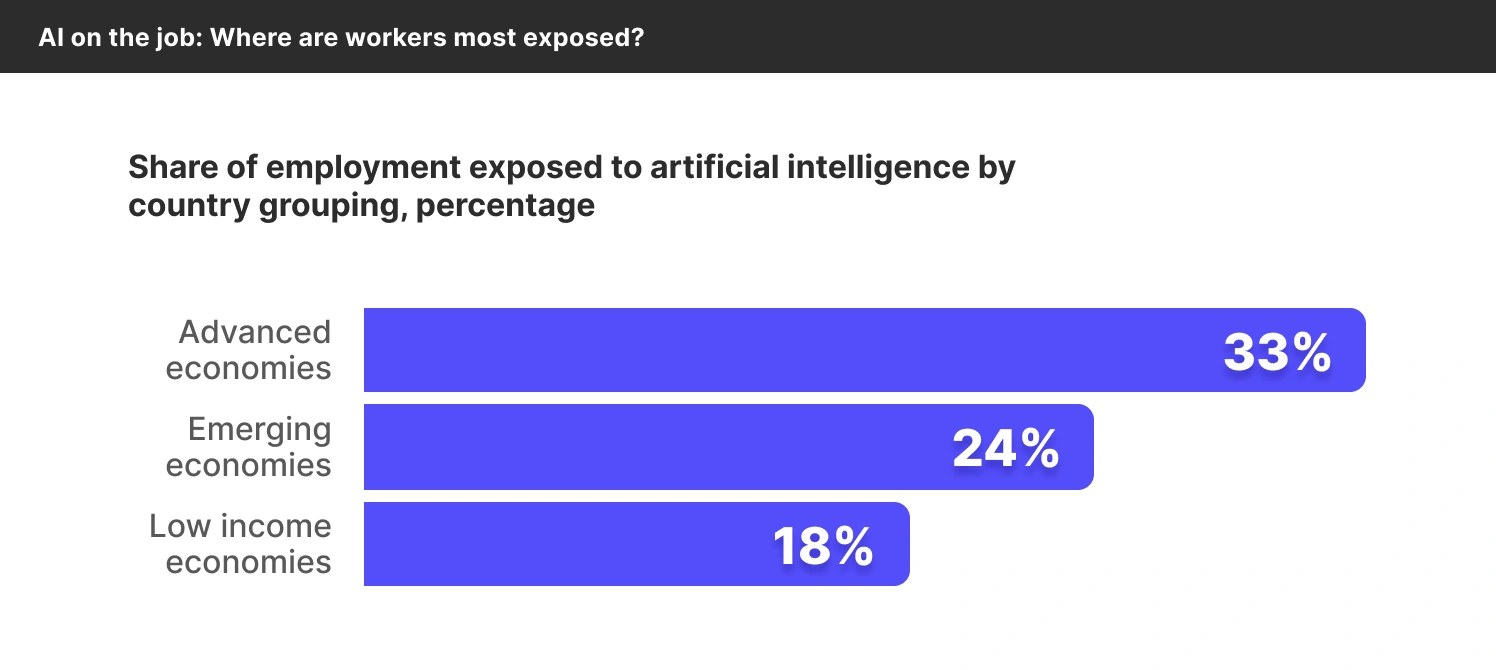The artificial intelligence (AI) industry is poised for significant growth in the years ahead. According to a new UN Trade and Development (UNCTAD) report1, the global AI market could be set to grow from $189 billion in 2023 to $4.8 trillion by 2033 – a 25-fold increase in just a decade.
In this post, we are going to look at some potential implications of this projected industry growth. We’ll also highlight a few companies that are spearheading the AI revolution today.
AI Could Revolutionize Industries
For many of us, artificial intelligence is already reshaping the way we work. From content creation to product design, the technology is augmenting human capabilities and driving innovation. Looking ahead, we can expect to see AI used across far more industries. According to UNCTAD, over a quarter (27%) of jobs in advanced economies could be enhanced by artificial intelligence, boosting productivity significantly.
It’s worth pointing out that AI enhancement isn’t just about doing things faster; it’s also about unlocking new levels of innovation. The beauty of this technology is that it’s able to handle complex data analysis, identify hidden patterns, and generate novel solutions. So, it has the potential to advance a range of industries. From healthcare to financial services, it could lead to products and services that were previously unimaginable.
Of course, while AI has the potential to create new opportunities, it’s also raising concerns about job displacement. UNCTAD states that up to one third (33%) of jobs in advanced economies are at risk of automation while nearly a quarter of jobs (24%) are at risk in emerging economies. So, governments will need to invest in reskilling, upskilling, and workforce adaptation. This will help to ensure that AI enhances employment opportunities rather than eliminates them.
Source: UNCTAD, as of April 7, 2025
Note: Data from 125 countries in panel (a) and from 59 countries in panel (b); middle-income countries are the average of upper middle-income countries and lower middle-income countries, weighted by the number of countries in the sample.
Another risk is that developing countries – which often lack the tech prowess of advanced countries – could be left behind as AI advances. UNCTAD notes in its report that in 2022, the US and China held 60% of all AI patents. To compete in an AI-driven world, developing countries will need to rethink industrial policies, shifting the focus towards technology and innovation. They will also need to invest in education and digital infrastructure to build skilled workforces and ensure widespread access to the benefits of AI.
Overall, however, the technology has enormous potential. While concerns about job displacement are valid, AI could drive significant productivity gains across the global economy over the next decade.
AMD: Providing the Computing Power For AI
Zooming in on companies at the heart of the AI revolution, Advanced Micro Devices or AMD (5.67%) is increasingly looking like a key player when it comes to processing power. It’s a global semiconductor company that is known for high-performance processors and powerful graphics processing units (GPUs).
Back in October, AMD launched the Instinct MI325X – an AI chip designed to rival Nvidia’s Blackwell GPU. And it appears to be having a lot of success with this product. For Q1 2025, sales in AMD’s data center segment – which includes AI GPUs – were up 57% year on year to $3.67 billion2. On the Q1 earnings call3, AMD CEO Lisa Su told investors that several hyperscalers have expanded their use of Instinct accelerators while a major AI model developer is using Instinct GPUs for inference (where a trained AI model uses its learned knowledge to make predictions or generate outputs based on new, previously unseen data).
It’s worth pointing out that in mid-May, AMD announced a deal4 to provide AI chips to HUMAIN, a new AI subsidiary of Saudi Arabia’s Public Investment Fund (PIF). This deal will see AMD and HUMAIN work together to deploy 500 megawatts of AI compute capacity over the next five years and build an AI infrastructure superstructure. HUMAIN will be responsible for overseeing end-to-end delivery, including hyperscale data centers, sustainable power systems, and global fiber interconnects, while AMD will provide AI GPUs and its ROCm open software ecosystem. Optimized to power AI workloads across enterprise, start-up and sovereign markets, the AI superstructure will be open by design and accessible at scale.
Palantir: Helping Organizations Leverage AI
Given the potential efficiency benefits of AI, businesses across the world are eager to utilize the technology, and one company that is making this happen is Palantir (2.38%). It develops software that is designed to help customers use their data to gain a competitive edge. Palantir’s main AI offering is known as AIP (Artificial Intelligence Platform). This is a powerful platform that allows organizations to leverage the tech company’s artificial intelligence and machine learning tools and rapidly deploy AI across their businesses.
Palantir’s recent Q1 earnings showed that the company has strong momentum at present. For the quarter, US commercial revenue was up 71% year on year to $255 million while total revenue was up 39% year on year to $884 million. During the quarter, the company closed 139 deals of at least $1 million, 51 deals of at least $5 million, and 31 deals of at least $10 million. On the back of these results, Palantir raised its guidance for 2025 – it now expects total revenue growth of 36% and US commercial revenue growth of 68%.5
Alphabet: Bringing AI to Consumers
Of course, consumers are keen to utilize AI too. And one technology company that is delivering here is Google owner Alphabet (4.03%). It has launched its own generative AI chatbot, Gemini, in an effort to compete with ChatGPT. It has also introduced “AI Overviews” to its search platform (this service now has around 1.5 billion monthly users across 100 countries6).
Additionally, Alphabet is rapidly embedding AI across its Workspace ecosystem. Today, users can use Gemini in Docs and Gmail for writing assistance and in Sheets for data analysis, formula generation, and insights. Meanwhile, they can use it in Drive to summarize long documents, synthesize information, and generate new files.
As for the popular Google Maps, the company is using AI here to help users discover new places and craft more memorable and enjoyable experiences. Tell Google what you’re looking for and its large-language models (LLMs) will analyze detailed information on more than 250 million places as well as trusted insights from its community of over 300 million contributors to quickly make suggestions for where to go7. Within Maps, AI is also being used to analyze real-time traffic data and road conditions to predict traffic congestion, suggest optimal routes, and even provide lane guidance.
Looking ahead, Alphabet is planning to continue rolling out innovative AI features across its product suite. This should help the tech giant establish itself as a dominant force in AI and position it for growth in the AI era.
Footnotes:
1UNCTAD, AI market projected to hit $4.8 trillion by 2033, emerging as dominant frontier technology, as of April 7, 2025
2AMD Reports First Quarter 2025 Financial Results, as of May 6, 2025
3AMD Q1 2025 Earnings Call, as of April 2025
4AMD and HUMAIN Form Strategic, $10B Collaboration to Advance Global AI, as of May 13, 2025
5Palantir, Letter to Shareholders, as of May 5, 2025
6Tech Crunch, Google’s AI search numbers are growing, and that’s by design, as of April 25, 2025
7Google blog, A new way to discover places with generative AI in Maps, as of February 1, 2014





